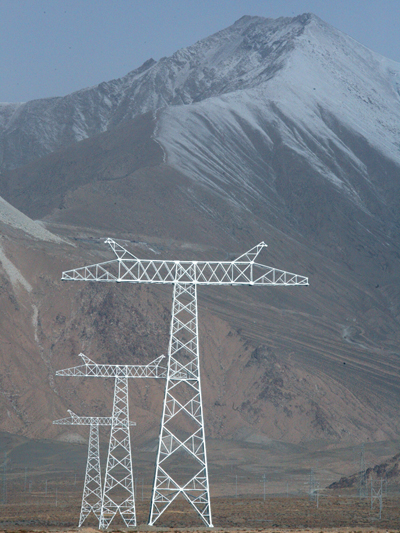
In October, 2011, Qinghai-Tibet grid interconnection project was finished and the grid began a trial phase. [Photo/ xindianli.com]
The power shortage in Tibet for years long will be eased with many large-scale power projects put into use. This winter, Tibet will not limit or cut power supply.
In previous winters, due to power shortage, Tibet would limit the power used in enterprises and factories to ensure the basic electricity needs of residents. As a result, many factories would stop their production or use self-purchased generators to pass the winter time.
In October, 2011, Qinghai-Tibet grid interconnection project was finished and the grid began a trial phase. In addition to the operations of two-cycle gas turbine in Donggar power plant, and the three units of Laohuzui power plant, the situation of power shortage in Tibet has been changed.
"It is great to have enough power. I don't have to stop the production of my factory and workers can be retained", said Drolkar, head of the production and marketing department of Lhasa Yuanda cement plant.
in previous years, due to power shortages, the factory has to stop production for three or four month every year. During the period, the factory has to afford the basic living expenses of the over 400 employees, but also tries hard to keep its employees.
According to Tang Wenjian, deputy manager of production and technology department, as there is no power limitation this year, the factory has invested over one million yuan to build a steel storage with capacity of 5000 tons of cement. Meanwhile, the salary of each employee would be raised by 15%.
"Without power cut, my business is more smoothly," said Liu Dadong, manager of a hair salon in one of Lhasa’s busiest streets. In previous years, the power would be cut for two or three times a week, to keep business going, he has to buy a generator which may cost him more than 1,000 yuan to buy diesel at most.
To ordinary households, despite the power use have be ensured through measures made by the power sector, sometimes the power supply would be cut at the peak time. Dawa Dondrup, who lives in the eastern suburbs of Lhasa, was happy to know the power supply would be ensured this year. "Oil lamps and candles have no longer been used," Dawa said. And his grandchild can do his homework as night.
According to the data from Tibet electric power Co., LTD, the daily maximum load of power grid in middle Tibet reached 45,910 kilowatts, and increased by 22.53% over the previous year. The electric power and electricity both reached an all-time high. As of now, power supply and demand have been kept balance in Tibet, and there is no power limitation or power cut.
On the Fifth Session of the Ninth National People's Congress opened on jun.5, Padma Tsinle, Chairman of Tibet Autonomous Region, said since the Qinghai-Tibet grid interconnection project began a trial phase, the history of isolated network of Tibet has been ended and the power shortage in Middle Tibet has been greatly eased.
